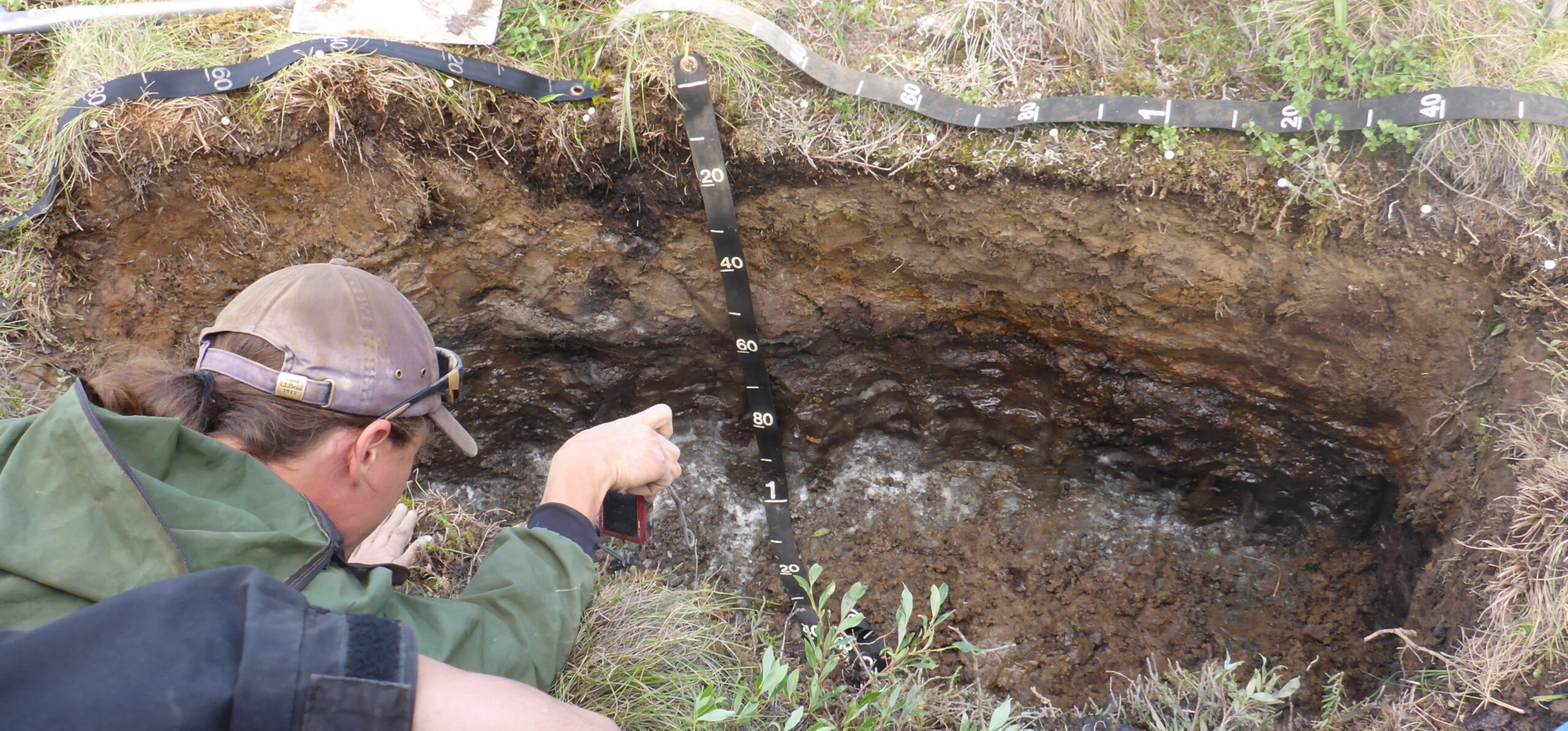September 03, 2024
Unexpected Soil Carbon and Nitrogen Storage Patterns in Hilly Arctic Landscapes
Multiscale sampling revealed unusually consistent near-surface carbon and nitrogen stocks from hilltops to valleys.

A mid-slope soil profile illustrates freeze-thaw mixing and warping of soil layers, with ice-rich soil near the bottom. In this profile, permafrost occurs below 60 centimeters on average.
[Courtesy Argonne National Laboratory.]
The Science
Understanding of the factors that influence where carbon and nitrogen are stored in arctic soils is incomplete. This information is needed to better predict how release of these elements due to thawing permafrost will impact future climate. In hilly regions, slow transport of soil downhill typically causes carbon and nitrogen stocks to increase at lower elevations. But in the Arctic Foothills of Alaska, researchers found similar carbon and nitrogen stocks at all slope positions within the top meter of soil. Localized freeze-thaw processes and other factors helped produce this unexpected storage pattern.
The Impact
This study provides new insights that challenge how researchers predict patterns of near-surface soil carbon and nitrogen stocks in hilly arctic landscapes. It also brings attention to how unique, smaller-scale processes in permafrost regions can override the effects of larger-scale soil transport processes. Further sampling is needed to fully grasp how and where these competing processes alter expected hillslope patterns.
Summary
To better understand how topography affects the amounts and pattern of carbon and nitrogen storage in hilly permafrost soils, a team of researchers studied two broad hillslopes in the Arctic Foothills of Alaska. At each site, the team took multiple samples nested within each of seven slope positions, from hilltop to valley. Unlike other hilly landscapes where downhill soil transport increases carbon and nitrogen stocks at lower elevations, the team found similar carbon and nitrogen stocks at all slope positions within a meter of the surface. At these sites, cryoturbation (freeze-thaw mixing of surface organic materials into deeper soil) was enhanced by a relatively thick and stable mantle of loess (silty windblown deposits). This process and variable ground ice contents disrupted typical, larger-scale carbon and nitrogen transport and accumulation mechanisms. Sampling below the loess mantle was limited by rocky soil conditions except at lower slope positions. These deeper samples revealed large carbon and nitrogen stocks consistent with the expected hillslope patterns missing in the top meter of soil. This suggests the larger-scale influence of topography on carbon and nitrogen distributions may still occur, but only at greater depths in some permafrost landscapes. These findings provide new data and insights into the complexity of measuring and predicting carbon and nitrogen stocks in hilly permafrost terrain. They also underscore the importance of increased, widespread deep-soil sampling to better predict the long-term effects of climate change on these vulnerable arctic ecosystems.
Principal Investigator
Julie Jastrow
Argonne National Laboratory
jdjastrow@anl.gov
Co-Principal Investigator
Roser Matamala
Argonne National Laboratory
matamala@anl.gov
Program Manager
Brian Benscoter
U.S. Department of Energy, Biological and Environmental Research (SC-33)
Environmental System Science
brian.benscoter@science.doe.gov
Funding
This work was supported by the Biological and Environmental Research program within the U.S. Department of Energy’s Office of Science as part of the Soil Carbon Response to Environmental Change Science Focus Area.
Related Links
References
Ainuddin, I.H., et al. "Soil Carbon and Nitrogen Stocks Across Hillslopes Underlain by Continuous Permafrost in the Northern Arctic Foothills, Alaska, United States." Permafrost and Periglacial Processes 35 (4), 504–522 (2024). https://doi.org/10.1002/ppp.2244.

